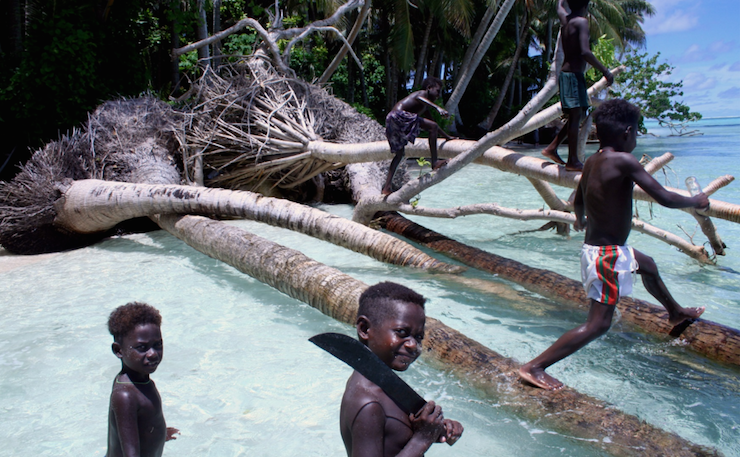Last month, the schools closed on a group of islands off Papua New Guinea’s coast. Climate change has claimed their crops, and large portions of the low lying atolls. A square meal is increasingly rare.
“They closed because the children weren’t concentrating,” Pais Taehu tells New Matilda. “Instead of concentrating, they were falling asleep because they weren’t having any food at home [before]coming to school.”
Taehu is the Chairman of a coalition of low-lying islands known as Atolls Temarai. The organisation acts as a voice for communities on the Mortlock, Nuguria, and Tasman Islands, which are some of the first to be claimed by climate change.
“Our shorelines are getting really really small,” Taehu says. “We have lost a lot of land – it’s been washed away. The salt water continues to really destroy our food gardens, and the sea walls we have built are washed away: The sea walls are out in the sea.
“The change of weather patterns is unpredictable. Now we are continuing to have storm surges and king tides when it’s not the season for king tides, and it’s not the season for storm surges and strong winds.
“Those are the huge impacts that our people are beginning to witness.”
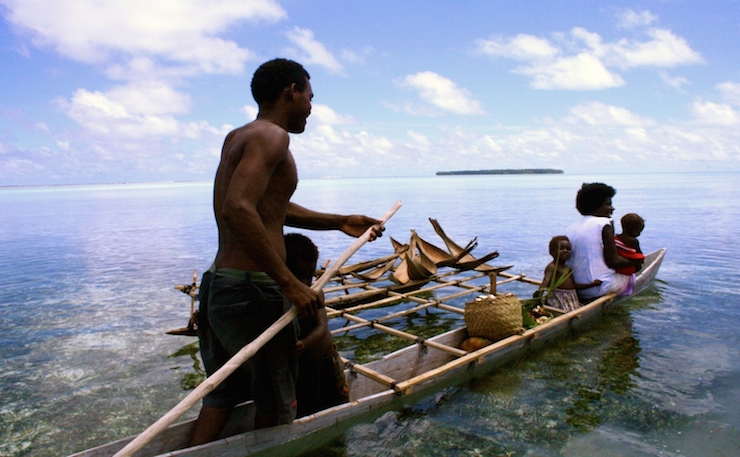
At the nearby Carteret Islands, the situation is similar — and it has provoked an extraordinary response.
“The science predictions on Carteret say between 2040 and 2050 the islands will be totally submerged,” according to Ursula Rakova.
“On Carteret, we have lost nearly all our food gardens. The sea washes over them, and we have lost a lot crops. We can no longer grow them. Forty years ago we grew a lot of our own food, we didn’t depend on the government to supply us with food.
“Today, as I’m talking, the schools on [the]Carterets have closed due to lack of nutritional diet for the children.”
Rakova has been the Director of Tulele Peisa since 2006, when the Council of Elders of the Carteret Islands founded the community organisation and charged it with developing an evacuation plan.
She’s now effectively stage-managing the controlled migration of 1,700 people.
That’s almost two-thirds of the Carteret’s 3,000-odd inhabitants — the world’s first climate refugees.
Taehu and the Temarai Association’s plans are less developed, but he recognises that the 3,000 more islanders who live on the Mortlock, Nuguria, and Tasman Islands will eventually need to go.
Rakova and Taehu are just winding up a speaking tour of Australia, supported by Friends of the Earth, in a bit to raise awareness of their peoples’ plight. Both have known for a long time that they’ll have to abandon their ancestral homelands.
“In 1984 Huene Island, which is one of six islands in the Carterets, was divided in half. That was when we started to realise and see what the sea was doing to us,” Taehu says.
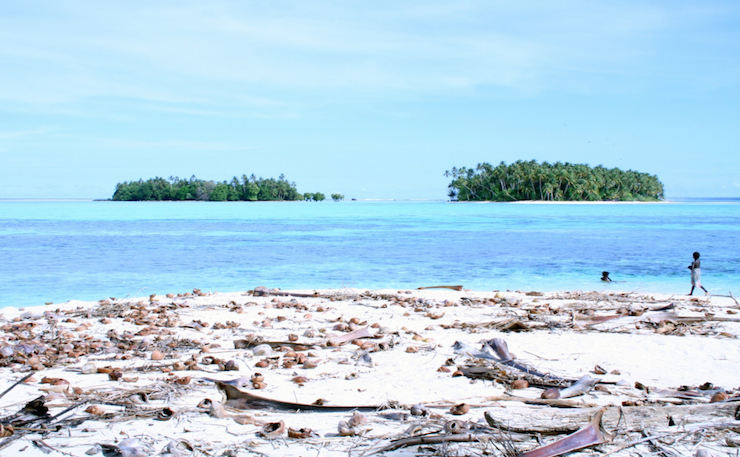
And as the ocean erodes what little land there is, Rakova says people are already forced to survive almost entirely on seafood. “That’s just about it,” she says. “It is a big problem for people’s health. You know, we lost about four people last year due to lack of nutritional diet.
“When they’re attacked by illnesses, especially the elderly, they’re not able to fight these diseases because they’re so weak. They do not take the proper meals they should be taking, and so people are dying of hunger as well.”
The Islands are scattered through the sea to the north east of Papua New Guinea, near the Solomon Islands. They fall under the political auspices of the Autonomous Region of Bougainville, which takes its name from the largest island in the troubled region of Papua New Guinea.
It’s just under 20 years since the ‘big island’ — Bougainville — marked the end of its savage civil war. Ironically, that’s where the world’s first climate refugees are now finding peace and security.
“We have relocated ten families so far,” Rakova says. “It’s 103 people currently living in our relocated site at the moment, and we want to move 140 more families.”
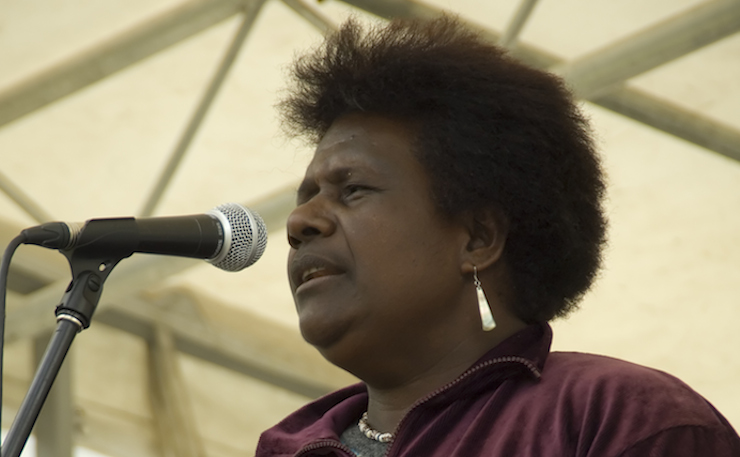
She says Australia has provided no funding to help — with the evacuation falling to community groups, funded almost entirely by various churches — but that this is where the islanders’ biggest neighbour can provide support.
“We have actually been working on relocating our people for 10 years now,” Rakova says. “[We’re] looking at $8,500 for one house, and so for 140 houses, we will need $1.6 million. I know Australia has this money, and this is why Australia has the opportunity and the ability to support us.”
She says the islanders feel “very much the same way as President Tong” of Kiribati, whose homelands are also sinking. At the Paris climate conference last year, President Anote Tong told New Matilda that the Coalition government simply “don’t care” about the fate of low-lying islanders.
Tong also attacked Prime Minister Malcolm Turnbull’s “selfish” determination to grow Australia’s coal exports as climate-vulnerable nations suffer, arguing those profits comes at the expense of entire nations’ cultures.
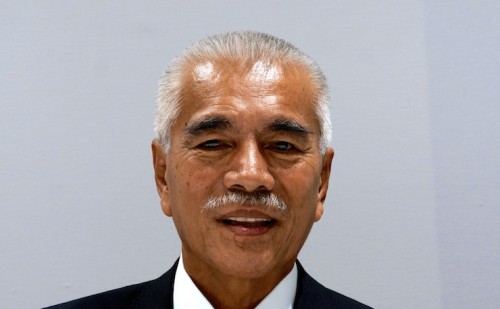
Rokova and Taehu are doing what they can to save theirs. “We are working…to document our traditional knowledge, and basically to protect our reefs,” Rakova says. “We still want to feel connected to the island by going back and doing our fishing.”
Despite the increasingly hostile environment, not everyone’s willing to leave. The Carteret Islands evacuation program involves 150 families, and less than two thirds of the islands’ population. Many of elderly will try to live out their lives on their homeland.
“When we go to our new locations, we want to continue providing food to the elderly people and those who will be left on the islands,” Rakova says. “So out of our surplus food gardens, we are continuing to send some food home to relatives.”
After ten years of work, only ten families have been moved so far. The focus has been on building houses, food security, and relationships with the ‘host community’ on mainland Bougainville.
As the hungry tide engulfs more land, the evacuation of islanders who don’t have electricity, and contributed virtually nothing to causing climate change, will obviously need to speed up. According to Rakova, there’s ultimately no other option.
“Leaving your own homeland is always an emotional stress. People are emotionally stressed and emotionally attached to the island. However, they will need to move in the near future, because the sea is not going to stop eroding the shorelines,” she says.
Donate To New Matilda
New Matilda is a small, independent media outlet. We survive through reader contributions, and never losing a lawsuit. If you got something from this article, giving something back helps us to continue speaking truth to power. Every little bit counts.

